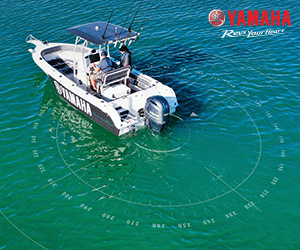The Spanish are coming! Josh Behrendorff 2015
As the weather begins to cool it not only signals a change in seasons but also in fish species that are abundant locally. This time of year usually has me servicing my barra gear for a few months of storage while I dust off a couple of my favoured mackerel outfits in anticipation for a bit of fun out on the mack patches.
The cooler water brings schools of Spanish mackerel to the waters off Townsville and they can be easily targeted from Cordielia Rock, Orchard Rock and Cape Cleveland. However I prefer to put in a few extra kilometres and head out to the locally known ‘mack patches’ which are located 35km NE of the coast guard ramp. This time of year the area begins to hold baitfish which brings in predators such as cobia, trevally, mackerel, tuna and even the odd billfish.
Last year I spent hours out there trying a variety of offerings from lures to slices and trolled baits. My most successful trips always fell around good tidal run, coupled with slow trolled fresh wolf herring. Needless to say, as soon as the winds came down I loaded the boat with a few rods for trolling and a couple of lighter spin outfits for any surface activity. Dropped into the local tackle store to grab a handful of the best wolf herring I could find along with a bag of gar and set off for the boat ramp praying that I could find a car park. I was leaving at lunch time, planning to troll for the afternoon until sundown as I have found that tide changes around sunrise/sunset seem to trigger the best bite.
After slugging it out through the inshore sea breeze I was pleasantly surprised that the conditions were comfortable for me and my two crew members in my 4.5m tinny. While Bob and Brenton set about dragging a couple of rods from the rod locker I got to work rigging the troll baits. I like to have two to three troll baits out while scouring the area for the baitfish. My troll baits on this particular trip was one chin rigged wolf herring, a skipping gar and a chin rigged gar. This gives me the opportunity to work a variety of depths and a couple of baits to see what the fish prefer to feed on.
The area of the mack patches that I like to work is rubbly style bottom that covers around about 1km2. We set up the two chin rigged baits on quality rod holders set at 90o to the boat around 15-20m back, while the skipping gar is set up shotgun in the middle of the boats wake and around 30m back. With the spread now set and the drags set to a fighting pressure I begin to zig zag the boat at 2-3kn scouring the area for either bait balls or schools of fish.
The sounder wasn’t showing too much in the early afternoon, yet we spotted a busting up school of fish around 500m away. I pointed the bow in that general direction hoping they would stay on the surface long enough for us to get a couple of casts into the feeding fish. Nearing the school we could see that they were mack tuna, a pair of 65g slugs were simultaneously thrown into the school of fish. The minute Bob’s lure touched the water he ripped his lure back in as fast as he could, where as I allowed my lure to sink for a couple of seconds hoping to snag a mackerel that may be feeding below the school. The sound of surface commotion and the dull mumble of the yammy four stroke was soon interrupted by a pair of screaming drags that almost harmonised. We were both hooked up tight to fish and we soon began yelling orders to Brenton who is a self-professed beginner fisherman. Brenton soon became the skipper and the deckie, clearing lines, steering the boat and finding the gaff. Bob’s mack tuna was soon tailed and heaved onboard and straight into the icy brine destined to be canned tuna while I was still battling something a little less cooperative. A long shimmering bar or chrome was soon raised from the depths. I called to the boys to be ready with the gaff, Bob soon handed the gaff over to me (he lost all confidence in gaffing fish mid last year when he lost what would have been a personal best Spanish mackerel estimated around 20kg.) So with the gaff in one hand, rod in the other and Brenton still at the wheel, I told him to engage the engine into gear to help bring the fish alongside the boat. I lowered the gaff into the water and outstretched my other arm holding the rod to bring the fish to the gaff. And with a short, sharp jab of the gaff I pinned the 8kg Spanish just behind the gills. This gave me my first chance to see how close the fish’s razor teeth were to biting through the 40lb mono leader that attached my slug to the 20lb braided mainline.
After boating these two fish, all the surface activity had dissipated and after chilled tinny we resumed our trolling pattern. The afternoon was getting on and the sounder was revealing more and more bait, although they were sitting closer to the bottom. In order to get my baits into the strike zone I would knock the engine into neutral as I sounded up a likely bait ball, allowing my trolled baits to gently waft to the bottom. After waiting for a couple of minutes I would drive off again. The third time I attempted this, my Saragossa screams into life as the wolf herring met its destiny. With Bob clearing the lines and Brenton taking over the wheel again, I took the strike. Holding on to the rod and watching the line scream off the reel, it reminded me just how much I have missed targeting the Spanish mackerel over the past couple of months. I was soon heaving another 8kg fish on board and straight into the esky. At this point it is worth mentioning that I prefer to rig my wolfies with trebles as the hook up rate is much more effective. De-hooking a thrashing Spanish mackerel with 4 trebles hanging out of its mouth is an accident waiting to happen. I will always kill the fish first and allow it to rest in the ice before removing the trebles. For this reason I always have two wolfies rigged at any one time so I can just attach a new one to my trolling rod ready for a quick reset of the lines.
Within minutes of resetting the lines my next wolfie was smashed again, I called out to Bob or Brenton to take the rod from me, yet both refused. The same routine as mentioned above played out and a third Spanish mack was dropped on the ice. With no more pre-rigged wolfies I got to work to quickly prepare another troll bait. The wolf herring was already defrosted so the first thing was to limber the wolfie up by bending the fish to free up the back bone, allowing it to have a more life-like swimming action. Next, I stick the wires from the chin guard up through skull of the fish and wrap a rubber band around to hold it in place. I then stick one hook of the trebles down to the underside of the fish ensuring the final treble is located in the fleshy part just in front of the tail fin.
A quick check of the rigged wolfie in the water beside the boat to check the swimming action is the final part before setting it out into the trolling spread. On this occasion I dropped the wolfie down into the middle of the other two rods in the middle of the bubble trail. We already had enough fish in the esky to feed our families, so we agreed one last fish and we call it quits. We really didn’t have to wait too long. The wolf herring was hit again but this time it didn’t sound correct, the sound of the screaming drag was interrupted by an almighty crack sound. I quickly spin from the helm to see the plastic rod holder had snapped clean in half and luckily the rod had somehow managed to wedge in the boat and not go overboard. I dove from my seat to get my rod out of the broken rod holder and take the strike, this time I insist that someone takes the rod from me. Brenton had never caught a big fish previously, and Bob still had not landed a Spanish mackerel yet. Brenton stepped up to the mark and did a remarkable job at managing this angry fish, considering it was his first fish bigger than a bream. The long screaming runs had us expecting that this was a big fish and as the fish appeared on the surface some 30-40m off the port we soon realised that this was going to be the biggest fish of the day. The second run was much stronger than the first as it headed off towards the sunset. We all got a little nervous as another boat soon came very close to us with his trolling lines out. With a bit of friendly sign language the boat soon turned away, but we were still nervous that his mackerel spoons may catch the line of Brenton’s fish. A long fight cut short, an exhausted Brenton was soon cheering as I gaffed and heaved his 13kg Spanish into the esky, a fitting way to end an exciting afternoon.
Although the gar fish didn’t produce on this particular trip, I have had other trips where the complete opposite plays out, the wolfies won’t get a touch while the gar fish are the choice bait.
Spanish Mackerel have an excellent yield of good eating flesh to the fish, for example, an average 10kg fish normally produces around 7kg of fillet. Mackerel fillets taste good fresh, but they don’t freeze the best, so it is important to only catch what you need. Until next time stay safe and tight lines.





